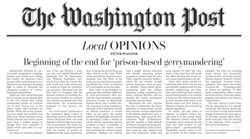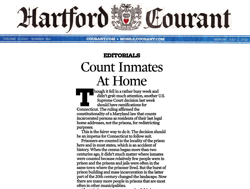The U.S. Supreme Court upheld the constitutionality of Maryland’s groundbreaking civil rights “No Representation Without Population Act.”
June 25, 2012
 For Immediate Release: June 25, 2012
For Immediate Release: June 25, 2012
Contact:
| Dēmos |
Anna Pycior |
212-398-1408 |
apycior@demos.org |
| Prison Policy Initiative |
Peter Wagner |
413-527-0845 |
|
Washington, DC – The U.S. Supreme Court today upheld the constitutionality of Maryland’s groundbreaking “No Representation Without Population Act,” which counts incarcerated people as residents of their legal home addresses for redistricting purposes. The 2010 law was a major civil rights victory that ended the distortions in fair representation caused by using incarcerated persons to pad the population counts of districts containing prisons.
The law upheld today is a state-based solution to the long-standing problem in the federal Census of counting incarcerated people as residents of the prison location, even though they cannot vote there and remain residents of their home communities for virtually all other legal purposes. The practice of prison-based gerrymandering particularly harms urban communities and communities of color that disproportionately contain the home residences of incarcerated persons. Other states have since passed similar laws, but the Maryland law was the only one to go to the Supreme Court.
“Today’s Supreme Court decision in Fletcher v. Lamone affirmed the constitutional ‘one person one vote’ foundation of our decade-old campaign to end prison-based gerrymandering,” said Peter Wagner, Executive Director of the Prison Policy Initiative and the nation’s leading expert on how the Census Bureau’s practice of counting incarcerated people as residents of the prison locations harms the democratic process.
The lawsuit was filed last November, and the civil rights community responded quickly to brief the lower court on the constitutionality of Maryland’s law. In an amicus brief, the Prison Policy Initiative and Dēmos, along with the Howard University School of Law Civil Rights Clinic, the ACLU of Maryland, the Maryland and Somerset County Branch NAACP, and the NAACP Legal Defense and Education Fund explained the basis and need for the landmark law. The lower court’s opinion, affirmed today, rejected the allegation that the law was somehow dilutive of minority voting rights, finding that the No Representation Without Population Act was an historic Maryland civil rights victory:
“As the amicus brief … makes clear, the Act was the product of years of work by groups dedicated to advancing the interests of minorities.”
Brenda Wright, Vice President for Legal Strategies at Dēmos, hailed today’s ruling in Fletcher v. Lamone: “The Supreme Court’s ruling is a huge victory for the national campaign to end prison-based gerrymandering. This decision sets an important precedent that will encourage other states to reform their redistricting laws and end the distortion in fair representation caused by treating incarcerated persons as residents of prisons.”
Today’s decision in Fletcher v. Lamone constitutes the most significant court ruling to date on the factual and legal justification for states to reallocate incarcerated persons to their home residences for purposes of redistricting. The ruling upheld today noted that “the Act is intended to ‘correct for the distortional effects of the Census Bureau’s practice of counting prisoners as residents of their place of incarceration.'” It further noted that
“These distortional effects stem from the fact that while the majority of the state’s prisoners come from African-American areas, the state’s prisons are located primarily in the majority white First and Sixth Districts. As a result, residents of districts with prisons are systematically ‘overrepresented’ compared to other districts.”
The plaintiffs in Fletcher challenged Maryland’s right to correct where incarcerated people are counted for the purpose of drawing congressional districts. “Congressional districts are held to the highest standards to ensure population equality.” said Brenda Wright of Dēmos. “The Court’s decision that Maryland’s law satisfies the strict standards applicable to congressional districts clears the path for other states to pass similar laws at all levels of government.” New York, Delaware and California have already enacted similar legislation, and advocates are calling on the Census Bureau for a national solution. “Today’s ruling by the U.S. Supreme Court affirming that Maryland’s law both meets constitutional requirements and was fairly implemented will hopefully encourage the Census Bureau to change its policy on where incarcerated people are counted in the 2020 Census” said the Prison Policy Initiative’s Peter Wagner.
##
 Tomorrow, the Washington Post will run my op-ed Beginning of the end for ‘prison-based gerrymandering’. The piece reviews last month’s Supreme Court ruling that summarily affirmed Maryland’s “No Representation Without Population Act” that counts incarcerated people as residents of their home addresses for redistricting purposes. This decision gives the green light to states to eliminate the repugnant practice of prison-based gerrymandering.
Tomorrow, the Washington Post will run my op-ed Beginning of the end for ‘prison-based gerrymandering’. The piece reviews last month’s Supreme Court ruling that summarily affirmed Maryland’s “No Representation Without Population Act” that counts incarcerated people as residents of their home addresses for redistricting purposes. This decision gives the green light to states to eliminate the repugnant practice of prison-based gerrymandering.
 For Immediate Release: June 25, 2012
For Immediate Release: June 25, 2012



